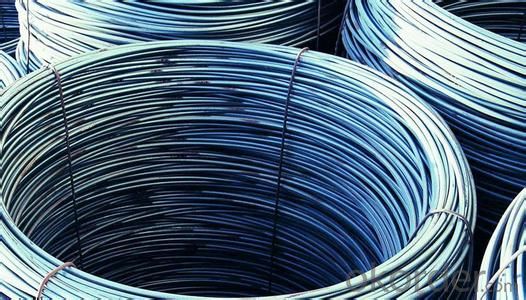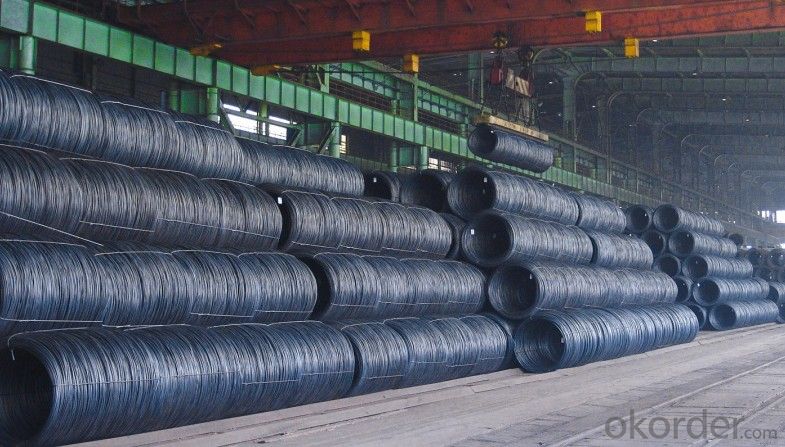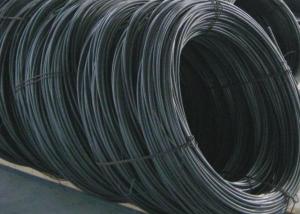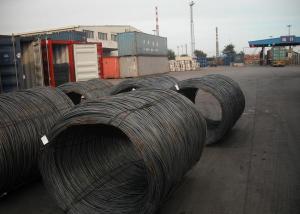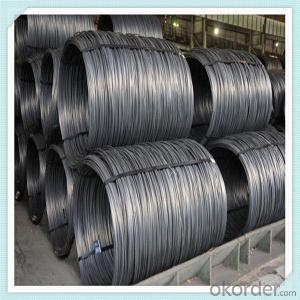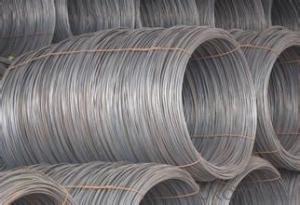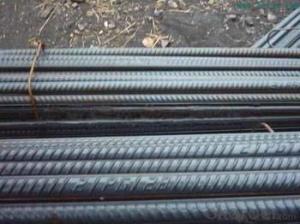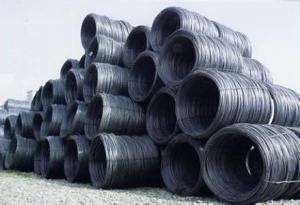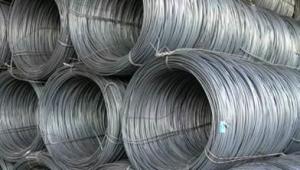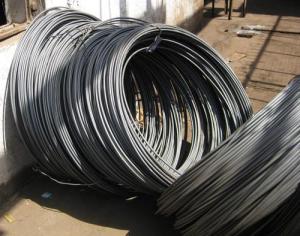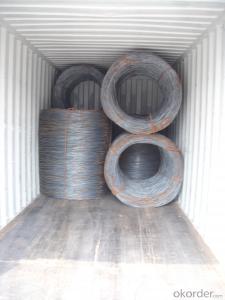HPB300 Hot rolled wire rod
- Loading Port:
- China Main Port
- Payment Terms:
- TT OR LC
- Min Order Qty:
- -
- Supply Capability:
- -
OKorder Service Pledge
OKorder Financial Service
You Might Also Like
The concept of Wire section perimeter is very small, common product specifications diameter is 5-13mm. According to the rolling mill can be divided into different high-speed wire (wire rod) and ordinary wire (S & P line) two.
2 classification
Wire usually made of ordinary carbon steel and high quality carbon steel.According to the different steel distribution directory and use the wire,including ordinary low carbon steel hot-rolled plate bar, wire rod, high quality carbon steel, Quenched and tempered threaded rods for welding wire, steel wire rope wire, piano wire wire and stainless steel wire rod etc..
1 ordinary low carbon steel hot-rolled plate bar (GB701-65), the ordinary low carbon steel hot-rolled plate by low carbon ordinary carbon structural steel oryield point of low carbon structural steel and rolling, is the largest amount ofwire varieties, the most widely used in the wire rod, also known as the cord.
Main application: general line is mainly used in construction of reinforced concrete structure reinforcement steel, cold drawn steel wire can also bedrawn from, as binding etc..
2 ordinary low carbon steel hot rolled wire rod without torsion cold control,(ZBH4403-88), torsion free and controlled cooling, hot rod by torsion free high speed wire rod mill rolling controlled cooling made, material and general line is the same, but without the mechanical properties of hot rolled wire rod torsion cold control, high size precision, good surface quality, high.
Main uses: no twist and controlled cooling, size precision of hot rolled wire rodis divided into A, B, C level three. A, B, C level accuracy is suitable for drawing,construction, packaging and electrode uses, B, C level accuracy is suitable for processing into bolts, screws and nuts.
3 carbon steel wire rod (GB4354-84), the high quality carbon steel wire rod is made of high-quality carbon structural steel and rolling. Is one of the larger amount of wire varieties varieties.
Main purposes: quality carbon steel wire is mainly used for manufacturingcarbon spring steel wire, oil tempered carbon spring steel wire, prestressed steel wire, high strength and high quality carbon structural steel wire,galvanized steel wire, galvanized wire rope etc..
4 high quality carbon steel hot rolled wire rod without torsion cold control,(ZBH44002-88), the high quality carbon steel hot rolled wire rod without torsion cold control, by the torsion free high speed wire rod rolling mill and rolling,controlled cooling process after rolling. Compared with the high quality carbon steel wire rods, high size precision, good surface quality, with high mechanical properties.
Main application: mainly uses the high quality carbon steel wire rod with the same. Commonly used in the manufacturing of carbon spring steel wire, oil tempered carbon spring steel wire, prestressed steel, quality carbon structural steel wire, galvanized steel wire etc..
5 steel wire rod (YB349-64), steel wire for rope with wire is hot rolled quality carbon structural steel strips of disc.
Main purposes: quality carbon structural steel wire rope with wire rod available in 35, 40, 45, 55, 60, 65, 70, 75, 80 and 85 grades of manufacturing. The chemical composition of GB699 (meet the technical requirements for steelquality carbon structural) regulations.
Torsion free control of cold and hot rolled wire rods for 6 steel wire(ZBH44004-88), torsion free control of hot and cold rolling plate and used high quality carbon structural steel with steel wire for rope rolling in no twist wire rod mill, the rolling control cooling and made. This rolling into wire rod, high size precision, good surface quality, excellent mechanical performance.
Main uses: mainly used for drawing steel wire and steel wire strand.
7 carbon welding steel wire rod (GB3429-82), carbon welding steel wire rodmade of low carbon hot rolled quality carbon structural steel made.
Main uses: mainly used in the manufacture of manual electric arc weldingelectrode.
8 carbon welding rod steel torsion free and controlled cooling, hot rod(ZBH44005-88), carbon welding rod steel torsion free and controlled cooling,hot rod is blocked in a twisted wire rod rolling, and rolling control cooling and made. The high size precision, good surface quality, superior performance, is a kind of high quality welding steel wire rod.
Main uses: mainly used for carbon steel hot rolled strip steel core discmanufacturing welded with the medicine skin.
9 structural alloy steel hot rolled wire coil (GB3077-82), alloy structure steelhot rolled wire rods by alloy structure steel as material and rolling. Alloystructural steel has a total of 26 Steel Group, 78 steel grades. Each productionplant according to any requirements and different use of selected grades for production.
Main uses: mainly used for structural alloy hot rolled wire drawing steel wire,metal products and structures.
10 carbon tool steel hot rolled wire coil (GB1298-86), carbon tool steel by high quality or high quality high carbon steel and rolling. The processing performance and wear-resisting performance is good, the price is cheap.
Main uses: mainly used for drawing steel ratio and manufacturing tools etc..
11 alloy tool steel hot rolled wire rod (GB1299-77)
Alloy tool steel is in the matrix of the carbon tool steel adding chromium,tungsten, molybdenum, vanadium, silicon, manganese, nickel and cobalt alloyelements and tempered steel. Compared with the carbon tool steel. It has good hardenability and cracking tendency of small, wear resistance and high heat resistance characteristics of heat treatment. Alloy tool steel, alloy tool steel hot rolled wire rod is composed of 5 steel group of 33 steel as the material and rolling. Are produced by the unit of the Dalian steel plant, Benxi steel andShaanxi steel etc..
Main purpose: is used for making the measuring tools, tools and cold and hot working die, shock resistant tool etc..
12 hot rolled spring steel wire rod
Spring steel is used in steel manufacturing springs or elastic element. The spring and the elastic element is mainly the use of the elastic deformationenergy absorption and storage, to mitigate the vibration and impact of theparts or do some action for the purpose of. Because it is periodic alternating inshock, vibration or long-term uniform stress conditions, so the requirements of spring steel has a high yield strength, especially to a higher ratio of yield strength (yield strength and tensile strength ratio) and high temperature resistance and corrosion resistance。
- Q: What are the different types of steel wire rod dimensional inspection methods?
- In the industry, there are multiple commonly utilized methods for inspecting the dimensions of steel wire rods. These methods are employed to ensure that the steel wire rods meet the specified requirements and are suitable for their intended applications. Some of the primary inspection methods for dimensions include: 1. Caliper measurement: This method involves the use of a caliper tool to measure the diameter of the steel wire rod. It is a basic yet effective technique that provides quick and accurate measurements. 2. Micrometer measurement: Micrometers, commonly used in the steel industry, offer more precise measurements compared to calipers. They are typically used to measure the diameter of the wire rod. 3. Optical measurement: Optical measurement methods utilize cameras, lasers, or other optical devices to capture images or collect data about the dimensions of the steel wire rod. These methods are non-contact and provide highly accurate measurements. 4. Laser scanning: Laser scanning technology is frequently employed to measure the profile or shape of steel wire rods. This method involves scanning a laser beam across the surface of the wire rod and analyzing the reflected beam to determine the dimensions. 5. Ultrasonic measurement: Ultrasonic measurement methods utilize sound waves to measure the dimensions of the steel wire rod. By sending ultrasonic waves through the material and measuring the time it takes for the waves to bounce back, the dimensions can be determined. 6. Coordinate measuring machine (CMM): CMMs are advanced measurement systems that utilize probes and computer software to measure the dimensions of the steel wire rod. These machines offer highly accurate and precise measurements. 7. Visual inspection: Visual inspection is a straightforward method that involves visually examining the steel wire rod for any defects or deviations from the specified dimensions. This method is often used as an initial inspection before employing more complex measurement techniques. These represent just a few of the numerous methods used to inspect the dimensions of steel wire rods. Each method has its own advantages and limitations, and the choice of the appropriate method depends on factors such as the required level of accuracy, the complexity of the wire rod's shape, and the available resources and equipment.
- Q: What are the standard fatigue resistance requirements for steel wire rod?
- The fatigue resistance requirements for steel wire rods vary depending on the specific application and industry standards. However, there are some general guidelines that can be taken into consideration. Industries such as automotive, aerospace, and construction place great importance on fatigue resistance when it comes to steel wire rods. These rods experience cyclic loading and stress, which can result in fatigue failure if the material is not designed to withstand these conditions. Fatigue tests, such as rotating bending or axial fatigue tests, are typically used to determine the fatigue resistance requirements for steel wire rods. These tests subject the wire rod to repeated cycles of loading and unloading under specific conditions, such as stress amplitude and frequency. Parameters such as fatigue strength, fatigue life, and fatigue limit are often used to quantify the fatigue resistance of steel wire rods. Fatigue strength represents the maximum stress level that the wire rod can endure for a specified number of cycles without failure. Fatigue life indicates the number of cycles that the wire rod can sustain before failure occurs. The fatigue limit, also known as endurance limit, is the stress level below which the wire rod can theoretically endure an infinite number of cycles without failure. The specific fatigue resistance requirements for steel wire rods can vary based on factors such as the intended use, material composition, and expected service life. These requirements are typically defined by industry standards and specifications, such as those established by organizations like ASTM or ISO. Manufacturers and engineers must carefully consider the fatigue resistance requirements for steel wire rods to ensure the safety and reliability of the final products. This involves selecting the appropriate material grade, conducting thorough testing and analysis, and adhering to industry standards and specifications.
- Q: What are the different surface defects that can lead to failure in steel wire rod?
- There are several different surface defects that can lead to failure in steel wire rod, including cracks, pits, scratches, inclusions, and scale.
- Q: How are steel wire rods used in the manufacturing of bicycle spokes for strength and durability?
- Steel wire rods are used in the manufacturing of bicycle spokes because they provide strength and durability to support the weight and stress exerted on the spokes while riding. The high tensile strength of steel wire rods allows the spokes to withstand heavy loads and resist deformation, ensuring a reliable and long-lasting performance for the bicycle.
- Q: How are steel wire rods used in the manufacturing of wire baskets?
- Steel wire rods are an essential component in the manufacturing process of wire baskets. These rods serve as the foundation and structural framework for the baskets. They are typically made from high-quality steel that provides strength, durability, and resistance to corrosion. The first step in using steel wire rods for wire basket manufacturing involves cutting them into the desired lengths. These lengths can vary depending on the size and design of the basket being produced. Once cut, the rods are then shaped into the appropriate form, which can be square, round, or rectangular, depending on the specific requirements of the basket. To create the wire basket, the shaped steel wire rods are interwoven or welded together. This process creates a sturdy mesh-like pattern, forming the body of the basket. The interlocking of the wire rods ensures the basket's structural integrity while allowing for ventilation and visibility. The steel wire rods used in wire basket manufacturing can also be coated or treated to enhance their properties. For example, they can be galvanized to provide a protective layer against rust and corrosion, making the basket suitable for outdoor use or in humid environments. Additionally, the rods can be coated with plastic or vinyl to add color and prevent scratching or damage to the items stored in the basket. Overall, steel wire rods are crucial in the manufacturing of wire baskets as they provide the necessary strength and structure for these versatile storage solutions. Their versatility allows for customization in terms of size, shape, and coating, making wire baskets suitable for a wide range of applications in various industries, including retail, agriculture, and transportation.
- Q: How is steel wire rod coated for improved performance?
- Steel wire rod can be coated for improved performance through a variety of methods, including hot-dip galvanizing, electroplating, and powder coating. These processes provide a protective layer on the surface of the wire rod, enhancing its corrosion resistance, durability, and overall performance.
- Q: What are the main factors affecting the product differentiation of steel wire rod?
- The main factors affecting the product differentiation of steel wire rod are the chemical composition and quality of the steel used, the manufacturing process and technology employed, the size and shape options available, the surface finish and treatment, and any additional features or value-added services provided by the manufacturer.
- Q: How are steel wire rods used in the production of wire mesh?
- Wire mesh production relies heavily on steel wire rods, which play an indispensable role. These rods undergo a process that involves heating them and passing them through dies to achieve the desired wire diameter. Typically, low-carbon steel is used to provide the necessary strength and durability for wire mesh applications. Once the shaping and desired diameter have been achieved, the steel wire rods are introduced into a wire mesh machine. This machine interweaves the individual wires, forming a grid-like pattern. The wire rods are positioned both vertically and horizontally and are mechanically connected at their intersections. The resulting wire mesh finds applications across various industries. It serves as a robust and dependable barrier for fencing and security purposes. Additionally, it is used in construction to reinforce concrete structures, enhancing their strength and stability. Wire mesh also finds utility in industries such as agriculture, mining, and filtration. To ensure the durability and reliability of the final product, the quality of the steel wire rods used in wire mesh production is of utmost importance. It is crucial to select high-quality rods with the appropriate tensile strength and corrosion resistance properties that meet the specific requirements of each application. In conclusion, the production of wire mesh relies on the shaping of steel wire rods to the desired diameter and their subsequent interweaving to create a grid-like pattern. The resulting wire mesh finds diverse applications in industries such as fencing, construction reinforcement, and filtration.
- Q: What are the physical properties of a steel wire rod?
- The physical characteristics of a steel wire rod encompass its size, strength, toughness, pliability, and electrical conductivity. Size: Steel wire rods are available in a range of sizes and diameters, typically spanning from 5.5mm to 20mm. The length of the rod can vary depending on the manufacturer and intended use. Strength: Steel wire rods are renowned for their exceptional tensile strength, allowing them to withstand substantial loads and tension without fracturing or distorting. This strength is a product of the steel's composition and the manufacturing procedure. Toughness: Steel wire rods possess a specific level of toughness, which pertains to their resistance against indentation or scratching. The rod's hardness can be influenced by the type of steel alloy employed and any heat treatment methods employed during manufacturing. Pliability: Steel wire rods are recognized for their remarkable pliability and capacity to bend without breaking. This pliability stems from the inherent ductility of the steel material, enabling the rod to be shaped and employed in a variety of applications, including construction, automotive, and electrical industries. Electrical Conductivity: Steel wire rods exhibit excellent electrical conductivity, rendering them suitable for applications requiring the transmission of electrical energy or signals. However, it is crucial to note that steel is not as conductive as other metals such as copper or aluminum. In conclusion, steel wire rods are highly valued for their amalgamation of strength, toughness, pliability, and electrical conductivity, which renders them versatile and extensively utilized across various industries and applications.
- Q: What are the safety regulations for steel wire rod manufacturing plants?
- The main purpose of safety regulations in steel wire rod manufacturing plants is to ensure the well-being and protection of workers, as well as to prevent accidents and hazards within the facility. These regulations cover various aspects of the manufacturing process, equipment, and workplace environment. One crucial safety regulation is the proper implementation of machine guarding. Machinery and equipment used in the manufacturing process must have sufficient guards to prevent accidental contact with moving parts, which can cause severe injuries. Regular inspections and maintenance of these guards are necessary to ensure their effectiveness. Another important safety regulation is the provision of personal protective equipment (PPE) for workers. This includes items like safety goggles, gloves, helmets, and steel-toed boots. Workers must wear PPE as required by the task being performed to protect themselves from potential hazards such as flying debris or falling objects. Fire safety is also a crucial aspect of the safety regulations in steel wire rod manufacturing plants. Measures to prevent fires, such as proper storage and handling of flammable materials, regular inspection and maintenance of fire suppression systems, and clearly marked emergency exits, are essential to minimize the risk of fires and create a safe working environment. Additionally, safety regulations often mandate regular training programs for employees. These programs should cover topics like hazard identification, emergency response procedures, proper handling of equipment and materials, and safe work practices. Ongoing training and education ensure that workers are aware of potential risks and have the knowledge to prevent accidents. Furthermore, safety regulations may require the implementation of safety protocols for the handling and transportation of steel wire rods. This can involve proper lifting techniques, the use of cranes or forklifts, and secure storage and transportation methods to prevent injuries and product damage. Overall, safety regulations in steel wire rod manufacturing plants are comprehensive and aim to create a safe working environment for employees. Compliance with these regulations is essential to prevent accidents, protect workers, and maintain the integrity of the manufacturing process.
Send your message to us
HPB300 Hot rolled wire rod
- Loading Port:
- China Main Port
- Payment Terms:
- TT OR LC
- Min Order Qty:
- -
- Supply Capability:
- -
OKorder Service Pledge
OKorder Financial Service
Similar products
Hot products
Hot Searches
Related keywords




